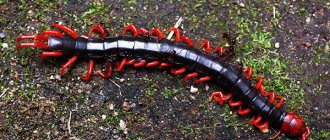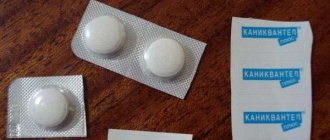- How many legs does a scolopendra have?
Whatever you say, the scolopendra is far from the most pleasant representative of the animal world, and it is also very dangerous for humans. Many species of scolopendra are poisonous and sometimes a scolopendra bite can even lead to fatal consequences; it is not for nothing that the giant scolopendra is included in the list of the most dangerous insects on the planet. Scolopendra belongs to the genus of millipedes, order Scolopendra. The name “scolopendra” is of ancient Greek origin and is translated into our language as “centipede”.
Description, structure, characteristics
Scolopendra is very reminiscent of a long and thick worm, black or brown with splashes of green. However, the color of some centipedes may differ depending on the species. The body length of the centipede is 10-15 cm, but sometimes it can reach 35 cm.
The body of the scolopendra consists of a head and a long torso, which in turn consists of twenty (and sometimes more) segments connected to each other by flexible
membranes protected by an exoskeleton. Each segment has its own pair of legs. The first pair of legs of the scolopendra are called the mandibles; they serve the scolopendra to grab potential prey and send it directly into its mouth.
The last pair of legs of the scolopendra is also different from the rest; it is large in size and serves as a kind of anchor for the insect, at the same time helping with movement through earthly burrows.
The head of the scolopendra is like a plate with eyes, two antennae and a pair of jaws. The scolopendra's compound eyes provide it with excellent vision and good orientation in space.
Where does scolopendra live?
Photo: Crimean scolopendra
Scolopendra can be found in all climatic regions. However, their population is especially expanded in places with warm climates: tropical forests of Central and South America, in the equatorial part of Africa, in southern Europe and Asia. Giant centipedes live only in tropical climates; their favorite place is the Seychelles. Centipedes live in forests, on mountain peaks, in dry, hot deserts, and in rocky caves. Individuals that live in regions with temperate climates do not grow large in size.
Interesting fact: It will not be possible to meet a giant scolopendra in our regions, since only small representatives of this species of arthropod live here.
Scolopendras prefer night life because they do not like bright light. They can't stand the heat, although they don't like rain either. Whenever possible, they choose people's houses as their homes. Here they can most often be found in a dark, damp basement.
In their natural environment, centipedes live in moist, dark places, most often in the shade under foliage. Ideal places for centipedes to exist are rotting tree trunks, litter of fallen leaves, the bark of old trees, crevices in rocks, and caves. During the cold season, centipedes take refuge in warm places.
Now you know where scolopendra is found. Let's see what this insect eats.
How many legs does a scolopendra have?
The number of legs of a centipede directly depends on the number of segments of the body, and it is usually from 21 to 23, since each segment has its own pair of legs, then any decent centipede has 42-46 legs. It is also worth remembering that each of the scolopendra’s legs has a poisonous gland and, for example, if it comes into contact with human skin, it can cause inflammation.
What does scolopendra eat?
Photo: Centipede insect
The centipede naturally has anatomical adaptations with which it successfully copes with catching prey:
- maxillomandibles;
- wide throat;
- poison glands;
- tenacious legs.
The centipede is a predator. When attacking prey, the scolopendra first immobilizes the victim and then slowly eats it. The likelihood of prey escaping from a centipede is very low, because not only does it move very quickly, it also makes attacking jumps.
Interesting fact: Scolopendra can move at speeds of up to 40 cm per second.
Advantages of centipedes when hunting prey:
- has good vertical running skills;
- the insect is very dexterous and agile;
- has a quick response to any vibrations in the air;
- at one time an individual can catch several victims at once.
Domestic scolopendras are flycatchers; they eat any insects: cockroaches, flies, mosquitoes, ants, bedbugs. Therefore, the flycatcher benefits the house in which it lives.
Forest scolopendras give preference to living creatures that live underground: earthworms, larvae, beetles. When it gets dark and the scolopendra comes out of its hiding place, it can hunt for grasshoppers, caterpillars, crickets, wasps and ants. Scolopendra is very voracious, she needs to constantly hunt. When hungry she becomes very aggressive. Large scolopendra also attacks small rodents: snakes, lizards, chicks and bats.
Nutrition
As you probably already guessed, our today's heroine, centipede, is a notorious predator of the insect world; other smaller insects act as a source of food for centipedes: earthworms, beetles,
crickets, grasshoppers, etc.
Scolopendra caught a grasshopper.
But the giant scolopendra can easily attack small ones
lizards, frogs, birds, small snakes and even bats. To catch the latter, the centipede, holding the surface with its claws, climbs to the ceiling where it sleeps, then attacks the bat with its front claws, simultaneously wrapping itself around the victim and injecting poison into it.
Natural enemies of centipedes
Photo: What scolopendra looks like
In their natural habitat, scolopendras are also hunted by predators. At the same time, the diversity of species that eat centipedes is relatively small. The most dangerous natural enemies of the centipede are frogs, toads, small mammals (shrews, mice), and birds. Owls love to hunt centipedes. Also, scolopendra is a nutritious protein food.
Pets such as dogs and cats also eat flycatchers. But this can carry a certain danger, since parasites often live inside centipedes. When an animal eats a scolopendra infected with the parasite, it also automatically becomes infectious. Scolopendras are a tasty morsel for snakes and rats.
Interesting fact: A large scolopendra can eat a smaller scolopendra.
Some peoples to this day consider scolopendra as a tasty and healthy food, because its body contains a lot of protein. In certain cultures, there is a belief that centipedes, as food, cure many diseases that are incurable with drugs.
Traditional medicine does not recommend eating scolopendra as food for people, especially in its raw form, because most individuals on the planet are infected with parasites. A dangerous parasite that lives in the body of a centipede is the rat lungworm. This parasite causes a dangerous disease that leads not only to incurable neuralgic diseases, but even to death.
Types: photos and names
There are about 600 species of these insects in nature, but we will describe the most interesting of them.
Giant scolopendra
As you probably already guessed from the name, this is the largest scolopendra, its body length reaches 35 cm. It is also the most dangerous, since its bite can be fatal to humans. The giant scolopendra lives in the tropics of South America.
Ringed scolopendra (Crimean scolopendra)
In our country it is better known as Crimean scolopendra, since its habitat is Southern Europe, including our Ukrainian Crimea. The Crimean scolopendra is not as large (and not as dangerous) as the giant one, its body length is on average 10 cm. The ringed scolopendra has a golden yellow color and is a very fast insect that eats other smaller insects.
California scolopendra
The Californian scolopendra lives in the arid regions of the Southern United States and Mexico. Its body length reaches 20 cm. It is distinguished by its bright orange color. Although its venom is not as toxic as that of the giant scolopendra, it can nevertheless easily cause inflammation of the skin in humans upon contact with the poisonous limbs of this centipede.
Scolopendra Lucas
Scolopendra Lucas also lives in Southern Europe. Its body is rusty in color and its head is heart-shaped.
House scolopendra (flycatcher)
The smallest and most harmless of centipedes, its body length is only 3 to 6 cm. Also, unlike its dangerous relatives, it has no poison and, as a result, does not pose any threat to humans. It lives in southern Europe, the Mediterranean and also in North Africa. It got its name because of its habit of settling in people’s houses, and although, as we have already noted, this scolopendra does not pose a threat, nevertheless, its presence in the house is not at all desirable. The domestic scolopendra feeds on small insects, usually flies, which is why it is even nicknamed the flycatcher.
Chinese scolopendra
This representative of the scolopendra kingdom lives in Asia, in particular China, and also in Australia. It is distinguished by its red color, which is why it is also known as the Chinese red centipede. Interesting fact: the inventive Chinese have learned to use the venom of the Chinese scolopendra for medical purposes; in the treatment of various skin diseases, it promotes the healing process in small doses.
Lifestyle and habitat
In natural habitats, scolopendras choose moist places under the shade of foliage for shelter. Sun rays and dry air dry out their bodies, so they accumulate in rotting trunks, under the bark of old trees, in litter of fallen leaves, in crevices of rocky slopes, and caves.
House centipedes also appear in rooms with high humidity - bathrooms, basements. Warmth and dampness are ideal living conditions for labiopods. In cold weather they hide and are not active.
Scolopendra poisonous is a real predator. Long antennae are the main sensory organ that helps to navigate and identify the victim. Primitive eyes detect the intensity of the light flux.
Large species of centipedes are very dangerous for small mammals, reptiles, and insects. The poisonous bite paralyzes the victim, then the scolopendra begins to slowly eat the prey. Excellent hunters are active at any time of the day, but the effectiveness of night forays for prey is higher.
During the day, even a large scolopendra fusses a lot, trying to hide so as not to become someone’s prey. Snakes, rats, and wild cats feed on predatory centipedes. Such food can be harmful for them due to parasites on the body of arthropods and poisonous accumulations in the internal glands.
The territories of Southern Europe and North Africa are considered the homeland of centipedes. Millipedes are widespread in Moldova and Kazakhstan. Small species are found everywhere.
Most species live alone. Social life is not inherent in arthropods. Aggression towards relatives is rare, but fights lead to the death of one of the rivals. Scolopendras bite each other and freeze, clinging to the enemy. One of the centipedes dies.
Reproduction
Scolopendras become sexually mature by the second year of life. The act of copulation itself usually takes place in the silence of the night, so that no one can disturb the love idyll of a centipede couple. During sexual intercourse, the male produces a special cocoon, located in the last segment of his body; this cocoon contains seminal fluid - a spermatophore. During mating, the female draws this fluid into her genital opening, and a few months after mating she lays eggs/larvae. Moreover, up to 120 eggs are released per clutch, but not all survive. After a few more months, small ones emerge from the scolopendra larvae.
Is scolopendra poisonous? Is scolopendra dangerous for humans?
The jaws with which the centipede catches its prey consist of 6 segments. The outermost one is a sharp claw curved inward. Inside the jaw there is a channel for the poisonous gland, and at the tip of the claw there is a hole through which the poison is injected into the victim.
Scolopendra venom contains substances that cause severe pain, swelling, inflammation and numbness of tissues. The pain from a scolopendra bite can last from several hours to a couple of days.
As already mentioned, scolopendra can mistakenly attack a person, but the venom is not enough to kill or paralyze an adult. But scolopendra is more dangerous for a child who has not yet developed a strong immune system. In this case, an attack by a large individual can lead to serious consequences.
Females are more poisonous than males. Depending on the species and age, a scolopendra bite can have different consequences, even quite serious, in rare cases it can lead to death.
California scolopendra can harm a person without even biting him. Her body contains toxic mucus that is secreted when in danger. Contact with this mucus causes an acute allergic reaction.
The bite of the ringed scolopendra, which can be found in Russia, is quite painful, it is 20 times stronger than the bite of a wasp. In addition, even if it just runs over the skin, it will leave red spots on the body.
Danger to humans
Regarding the danger of scolopendra to humans, the giant scolopendra that lives in the jungles of South America is especially dangerous; its bite can actually cause severe poisoning, even death. As for the Crimean scolopendra living in our country, although it is not fatal, nevertheless, you should stay away from it.
Symptoms of a scolopendra bite (in particular our Crimean one):
hornet,
This discomfort lasts about two days.
Interesting fact: female scolopendras are more poisonous and dangerous than males.
Maintenance and care
The giant scolopendra, whose bite is extremely painful for humans, is often kept in captivity by centipede lovers. She is interesting to watch, but needs to be kept with caution - she is a fast and aggressive animal. Inexperienced lovers are better off abandoning such a dangerous “pet” because of the very likely possibility of being bitten. Since centipedes are flat and flexible, they can squeeze into a small gap and escape from the terrarium. They live in captivity for a long time - up to 7 years.
It is necessary to maintain relatively high soil and air humidity - animals are very sensitive to this indicator.
Centipedes in captivity feed on cockroaches, mealworm larvae and crickets. They eat slowly and infrequently. It is recommended to give them food 1-2 times a week.
What to do if you are bitten
First of all, of course, it is best to simply prevent the scolopendra from biting you. She herself is unlikely to specifically attack a person, but she can bite in a state of fright and self-defense. Very often, scolopendras have a bad habit of crawling into tourists’ tents, so to avoid unwanted guests:
- use a closed tent with a zipper, and even such a tent should not be left open unattended.
- Inspect your tent thoroughly before going to bed.
- In the morning, check your clothes and things for the presence of scolopendras, they like to arrange a shelter for themselves in these items.
- Also remain vigilant when turning over stones or collecting dry branches, as centipedes may be hiding there.
If it does happen that scolopendra runs across a person’s skin, leaving a mark in the form of an inflamed stripe, measures should be taken immediately:
- wash the affected area with soap and water or disinfect with alcohol.
- then apply a sterile bandage.
- to drink a lot of water.
- provide peace to the victim.
- Do not drink alcohol under any circumstances (it speeds up the body’s metabolism, and with it the effect of scolopendra poison).
- It is highly advisable to consult a doctor for professional medical help.
If a scolopendra has bitten a pregnant woman, a child, an elderly person, a person suffering from cardiovascular diseases or prone to allergic reactions, then immediately going to the hospital for professional medical help is mandatory!
Features of character and lifestyle
Photo: Scolopendra in the Krasnodar region
Scolopendra is a poisonous predatory insect that is a dangerous enemy for many insects and small animals. By biting its victim, the scolopendra paralyzes it with poison and slowly eats it. Since the centipede is active at night, it is more productive to hunt at this time of day. During daylight hours, the scolopendra itself hides from enemies so as not to become lunch for others, although during the day it is also not averse to feasting on it.
Centipedes prefer an antisocial life, so they live alone. The centipede shows aggression towards its relative extremely rarely, but if there is a fight between two individuals, one of them dies in any case. In relation to the surrounding world, scolopendra, as a rule, does not show friendliness. This is a nervous and angry insect, whose anxiety is caused by its eyes’ sensitive perception of the light and colors of the surrounding world.
Therefore, any animal or insect that disturbs the scolopendra automatically becomes its target for attack. It is almost impossible to escape from a centipede because it is very fast and agile. In addition, the centipede's digestive system, which digests food very quickly, requires constant replenishment of food supplies. Because of this, the scolopendra constantly needs to look for food.
Interesting fact: The Chinese scolopendra digests slightly less than half of its dinner within three hours.
Video
And in conclusion, an interesting film about scolopendra.
Author: Pavel Chaika, editor-in-chief of Poznavaika magazine
When writing the article, I tried to make it as interesting, useful and high-quality as possible. I would be grateful for any feedback and constructive criticism in the form of comments on the article. You can also write your wish/question/suggestion to my email [email protected] or Facebook, with respect, the author.
Author page
Does scolopendra live in the house?
Yes, a scolopendra can settle in your house and become your neighbor. She is attracted to warmth, dark and damp shelters, as well as places where insects gather. Residents of coastal areas especially often face this problem, so they need to be more careful: install mosquito nets on windows, do not leave doors open, and fight insects in the house.
On the one hand, such a neighborhood even has its advantages: the centipede does not eat human food, does not damage furniture, and at the same time it destroys all small invertebrates: flies, cockroaches, spiders.
But few people will like such a neighbor: the scolopendra has a terrifying appearance, and besides, it can attack if, for example, you accidentally step on it.
Another problem arises if there is a cat in the house. She will probably start hunting for the centipede, and if the pet manages to catch it, then eating such prey can have negative consequences, in particular, the centipede can be parasitized by ticks, which will spread to the cat.
The danger of the poison of a huge scolopendra
Centipede bite The venom of the giant centipede is fatal to small animals, and for humans it is a powerful toxin, causing symptoms of severe pain and swelling not only in the bitten area.
For example, when a hand is bitten, the entire limb up to the shoulder becomes enlarged, swollen, very painful for 2-3 hours, signs of inflammation and toxicity appear: chills, fever, weakness, etc. The venom of the huge centipede contains the following chemicals: acetylcholine, serotonin, lecithin, histamine, thermolysin, hyaluronidase. When cold it retains its properties, but when heated or under the influence of alcohol and alkalis it is destroyed.
Important!
The bite of a giant scolopendra is especially dangerous for children and adults with weakened immunity or an allergic reaction of the body. There is only one known death in the world, which occurred in China, involving a child who was bitten on the head by a huge centipede.
This giant centipede bites everyone at the slightest threat due to the fact that it has very poor eyesight, which distinguishes only between light and darkness. Most often it attacks a person if you pick it up or crush it. There are cases when a huge centipede can run across the body completely harmlessly to a person, but the burn remains from the trace it leaves behind.
How to get rid of scolopendra in the house?
Although proximity to scolopendra has its advantages, there are still more disadvantages, so many people prefer to get rid of it.
The most obvious and easiest way to get rid of a centipede is to create unfavorable conditions for it, and then it will leave your house on its own.
Scolopendra loves humidity, so you need to thoroughly ventilate the rooms so that the air in them is drier. In addition, you need to get rid of insects, spiders and rodents in the house, then the scolopendra will leave in search of food.
Is Scolopendra an insect or not?
Scientifically: no, the scolopendra is not an insect. It belongs to the animal kingdom, a genus of labiopods from the order Scolopendra.
- Kingdom: Animals;
- Phylum: Arthropods;
- Class: Labiopods;
- Order: Scolopendra.
They are even classified as a separate order of Scolopendras. Thus, centipedes are animals.
Scolopendra - scientific classification
Domain: Eukaryotes Kingdom: Animalia Subkingdom: Eumetazoa No rank: Bilaterally symmetrical No rank: Protostomes No rank: Moults No rank: Panarthropoda Phylum: Arthropods Subphylum: Tracheenobreathes Superclass: Millipedes Class: Labiopods Subclass: Pleurostigmophora Order: Scolopendras Family: True scolopendras Subfamilies quality : Scolopendrinae Tribe: Scolopendrini Genus: Scolopendra Species: Scolopendra
Double-tailed drupe, common drupe, geophila, incomplete











